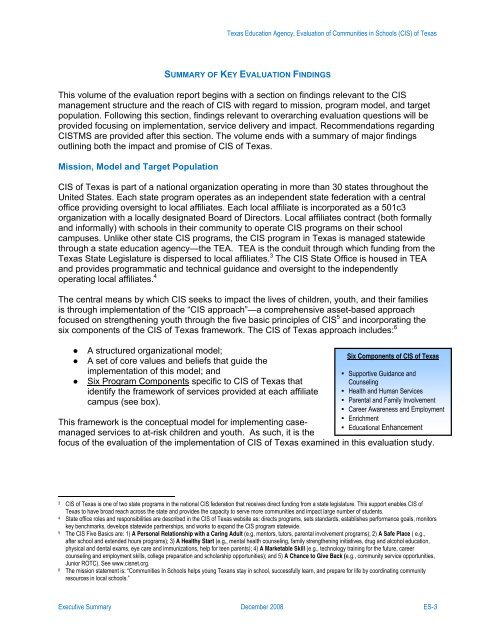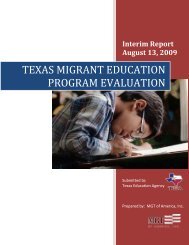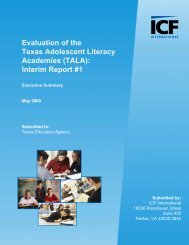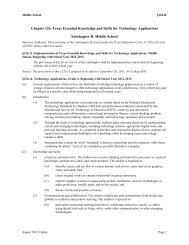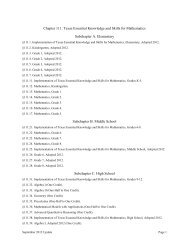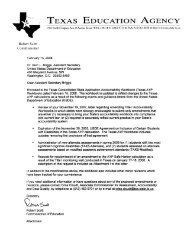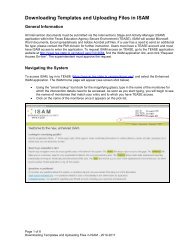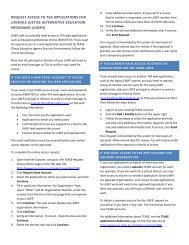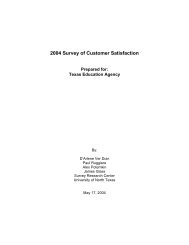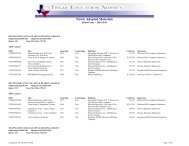CIS of Texas Evaluation Fiinal Technical Report - TEA - Home ...
CIS of Texas Evaluation Fiinal Technical Report - TEA - Home ...
CIS of Texas Evaluation Fiinal Technical Report - TEA - Home ...
You also want an ePaper? Increase the reach of your titles
YUMPU automatically turns print PDFs into web optimized ePapers that Google loves.
<strong>Texas</strong> Education Agency, <strong>Evaluation</strong> <strong>of</strong> Communities in Schools (<strong>CIS</strong>) <strong>of</strong> <strong>Texas</strong><br />
SUMMARY OF KEY EVALUATION FINDINGS<br />
This volume <strong>of</strong> the evaluation report begins with a section on findings relevant to the <strong>CIS</strong><br />
management structure and the reach <strong>of</strong> <strong>CIS</strong> with regard to mission, program model, and target<br />
population. Following this section, findings relevant to overarching evaluation questions will be<br />
provided focusing on implementation, service delivery and impact. Recommendations regarding<br />
<strong>CIS</strong>TMS are provided after this section. The volume ends with a summary <strong>of</strong> major findings<br />
outlining both the impact and promise <strong>of</strong> <strong>CIS</strong> <strong>of</strong> <strong>Texas</strong>.<br />
Mission, Model and Target Population<br />
<strong>CIS</strong> <strong>of</strong> <strong>Texas</strong> is part <strong>of</strong> a national organization operating in more than 30 states throughout the<br />
United States. Each state program operates as an independent state federation with a central<br />
<strong>of</strong>fice providing oversight to local affiliates. Each local affiliate is incorporated as a 501c3<br />
organization with a locally designated Board <strong>of</strong> Directors. Local affiliates contract (both formally<br />
and informally) with schools in their community to operate <strong>CIS</strong> programs on their school<br />
campuses. Unlike other state <strong>CIS</strong> programs, the <strong>CIS</strong> program in <strong>Texas</strong> is managed statewide<br />
through a state education agency—the <strong>TEA</strong>. <strong>TEA</strong> is the conduit through which funding from the<br />
<strong>Texas</strong> State Legislature is dispersed to local affiliates. 3 The <strong>CIS</strong> State Office is housed in <strong>TEA</strong><br />
and provides programmatic and technical guidance and oversight to the independently<br />
operating local affiliates. 4<br />
The central means by which <strong>CIS</strong> seeks to impact the lives <strong>of</strong> children, youth, and their families<br />
is through implementation <strong>of</strong> the “<strong>CIS</strong> approach”—a comprehensive asset-based approach<br />
focused on strengthening youth through the five basic principles <strong>of</strong> <strong>CIS</strong> 5 and incorporating the<br />
six components <strong>of</strong> the <strong>CIS</strong> <strong>of</strong> <strong>Texas</strong> framework. The <strong>CIS</strong> <strong>of</strong> <strong>Texas</strong> approach includes: 6<br />
●<br />
●<br />
●<br />
A structured organizational model;<br />
A set <strong>of</strong> core values and beliefs that guide the <br />
implementation <strong>of</strong> this model; and <br />
Six Program Components specific to <strong>CIS</strong> <strong>of</strong> <strong>Texas</strong> that<br />
identify the framework <strong>of</strong> services provided at each affiliate<br />
campus (see box).<br />
Six Components <strong>of</strong> <strong>CIS</strong> <strong>of</strong> <strong>Texas</strong><br />
▪ Supportive Guidance and<br />
Counseling<br />
▪ Health and Human Services<br />
▪ Parental and Family Involvement<br />
▪ Career Awareness and Employment<br />
▪ Enrichment<br />
▪ Educational Enhancement<br />
This framework is the conceptual model for implementing casemanaged<br />
services to at-risk children and youth. As such, it is the <br />
focus <strong>of</strong> the evaluation <strong>of</strong> the implementation <strong>of</strong> <strong>CIS</strong> <strong>of</strong> <strong>Texas</strong> examined in this evaluation study. <br />
3 <strong>CIS</strong> <strong>of</strong> <strong>Texas</strong> is one <strong>of</strong> two state programs in the national <strong>CIS</strong> federation that receives direct funding from a state legislature. This support enables <strong>CIS</strong> <strong>of</strong><br />
<strong>Texas</strong> to have broad reach across the state and provides the capacity to serve more communities and impact large number <strong>of</strong> students.<br />
4 State <strong>of</strong>fice roles and responsibilities are described in the <strong>CIS</strong> <strong>of</strong> <strong>Texas</strong> website as: directs programs, sets standards, establishes performance goals, monitors<br />
key benchmarks, develops statewide partnerships, and works to expand the <strong>CIS</strong> program statewide.<br />
5 The <strong>CIS</strong> Five Basics are: 1) A Personal Relationship with a Caring Adult (e.g, mentors, tutors, parental involvement programs); 2) A Safe Place ( e.g.,<br />
after school and extended hours programs); 3) A Healthy Start (e.g,, mental health counseling, family strengthening initiatives, drug and alcohol education,<br />
physical and dental exams, eye care and immunizations, help for teen parents); 4) A Marketable Skill (e.g., technology training for the future, career<br />
counseling and employment skills, college preparation and scholarship opportunities); and 5) A Chance to Give Back (e.g., community service opportunities,<br />
Junior ROTC). See www.cisnet.org.<br />
6 The mission statement is: “Communities In Schools helps young Texans stay in school, successfully learn, and prepare for life by coordinating community<br />
resources in local schools.”<br />
Executive Summary December 2008 ES-3


